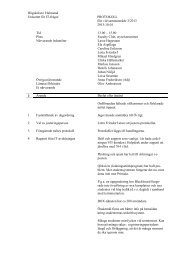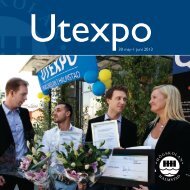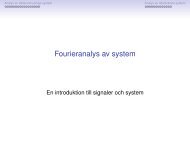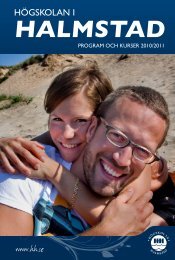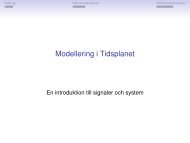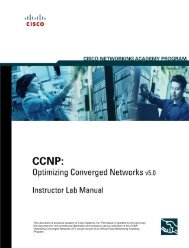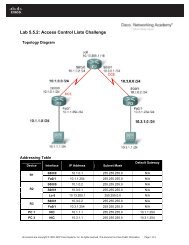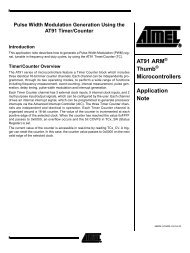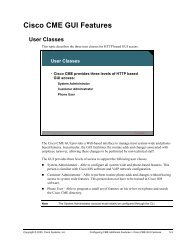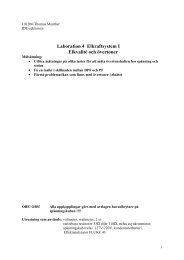ANNUAL REPORT 2012
ANNUAL REPORT 2012
ANNUAL REPORT 2012
Create successful ePaper yourself
Turn your PDF publications into a flip-book with our unique Google optimized e-Paper software.
characteristics of the architectures. The close contacts with<br />
the company will enable the researchers to get a more accurate<br />
view of the expected up-scaling and other development<br />
of manycore architectures.<br />
• The project will make use of the established connections<br />
with other partners from SMECY project such as Verimag/<br />
UFJ (Universite Joseph Fourier) and open new connection<br />
with other potention partner in Europe: ETH Zurich.<br />
4 Working Plan<br />
The complexity of future embedded manycore systems development<br />
requires an overall strategy establishing a close interaction<br />
between applications, programming models and hardware<br />
architecture platforms. The project is organized into three work<br />
packages:<br />
4.1 WP1. Studies of challenges in future signal processing<br />
applications<br />
An important aspect when it comes to the applications is the<br />
trend, i.e., the way that the requirements increase over time.<br />
We must find application development solutions for manycore<br />
platforms that can manage a continuous increase of the<br />
signal processing requirements. The requirements come from<br />
increased raw performance demands and/or performance per<br />
watt demand, as well as increased functional complexity. The<br />
objective of this WP is to give the application requirements<br />
needed to study how/if many-cores can increase the processor<br />
performance and allow the implementation of new features requested<br />
by future DSP applications. Outcome of this WP can<br />
be used as input for WP2 and WP3.<br />
4.2 WP2. Investigation of potential hardware architectures<br />
for future signal processing applications<br />
The key objective of this work package is to analyze the important<br />
trends in massively parallel processor architectures that<br />
could be used for future embedded signal processing applications.<br />
The investigations in this work package will focus on<br />
identifying the salient characteristics of the selected architectures:<br />
Adapteva, CoherentLogix and ElementCXI.<br />
Partners<br />
Halmstad University (HH)<br />
SAAB AB, business area electronic defence systems (SAAB)<br />
Free2move AB (F2M)<br />
Adapteva, Inc. (AI)<br />
Duration and Financial<br />
The project will run over 2 years (Sept 2011 – August 2013)<br />
Project size: ca 4.5 MSEK or more<br />
HH: 3.0 MSEK (=67%), funded by KKS (CERES+)<br />
SAAB EDS: 900 KSEK (=20%) in kind<br />
F2M: 600 KSEK (13%) in kind<br />
Adapteva: TBD (not counted as matching to KKS)<br />
References<br />
1. K. Asanovic, R. Bodik, B. C. Catanzaro, J. J. Gebis, P.<br />
Husbands, K. Keutzer, D. A. Patterson, W. L. Plishker, J.<br />
Shalf, S. W. Williams and K. A. Yelick, ”The Landscape<br />
of Parallel Computing Research: A View from Berkeley”,<br />
Technical Report No. UCB/EECS-2006-183, EECS Department ,<br />
University of California, Berkeley, Dec 18,<br />
2006<br />
2. Yury Markovskiy, Eylon Caspi, Randy Huang, Joseph<br />
Yeh, Michael Chu, John Wawrzynek, and André DeHon,<br />
“Analysis of Quasi-Static Scheduling Techniques in a Virtualized<br />
Reconfigurable Machine”, In Proceedings of the<br />
Tenth ACM International Symposium on Field-Programmable<br />
Gate Arrays (FPGA 2002), Monterey CA, pp. 196-<br />
-205, Feb. 24--26, 2002.<br />
3. J. Eker, J. Janneck, E. A. Lee, J. Liu, X. Liu, J. Ludvig, S.<br />
Sachs, Y. Xiong, “ Taming heterogeneity - the Ptolemy approach”,<br />
Proceedings of the IEEE, 91(1):127-144, January<br />
2003.<br />
4. P. Bourgos, A. Basu, S. Bensalem, K. Huang, J. Sifakis,<br />
Verimag Research Report N0 TR-2011-1, January 2011.<br />
5. W. Haid, K. Huang, I. Bacivarov, and L. Thiele, Multiprocessor<br />
SoC Software Design Flows. IEEE Signal Processing<br />
Magazine, 26(6):64—71, Nov. 2009<br />
4.3 WP3. Methods and Tools for Application Development<br />
on Manycores<br />
In this work package we will investigate tool infrastructure for<br />
DSP software development on manycore processors. We have<br />
chosen one tool chain from SMECY project: DOL/BIP [4],<br />
which was developed at ETH Zurich and Verimag. Inparticular<br />
we focus on using DOL (Distributed Operation Layer) [5] for<br />
modelling signal processing applications and architecture. The<br />
goal of the project is to complete development of the tool flow<br />
from software model to code generation for chosen architecture.<br />
One of the key components to an efficient implementation of<br />
such a tool flow is to make use of suitable and well-defined<br />
parallel models of computation, which capture parallelism and<br />
expose design time predictable execution behaviour.<br />
CERES Annual Report <strong>2012</strong><br />
21



